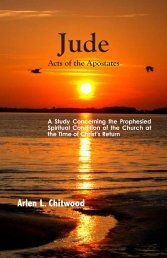Signs in John's Gospel - The Lamp Broadcast
Signs in John's Gospel - The Lamp Broadcast
Signs in John's Gospel - The Lamp Broadcast
You also want an ePaper? Increase the reach of your titles
YUMPU automatically turns print PDFs into web optimized ePapers that Google loves.
94 SIGNS IN JOHN’S GOSPEL<br />
statements <strong>in</strong> John 3:3, 5 with the events <strong>in</strong> Exodus chapter twelve<br />
— the Passover. <strong>The</strong> Passover, the first of seven Jewish festivals<br />
given to the Israelites under Moses (cf. Lev. 23:1ff), had to do with<br />
events which Nicodemus would have known that the nation had<br />
kept, which Israel had been observ<strong>in</strong>g year after year for centuries<br />
of time. And, be<strong>in</strong>g among Israel’s religious leaders, he could only<br />
have been among those participat<strong>in</strong>g <strong>in</strong> these events.<br />
<strong>The</strong> conversation between Christ and Nicodemus <strong>in</strong> John 3:1ff<br />
could only have been a conversation between Christ and a person<br />
who had already experienced the death of the firstborn, as seen <strong>in</strong><br />
Ex. 12:1ff. And, beyond this, accord<strong>in</strong>g to that clearly seen and<br />
stated <strong>in</strong> both the text and context, the subject matter had to do<br />
with the Jewish people and the k<strong>in</strong>gdom (a people who could only be<br />
viewed as saved, hav<strong>in</strong>g availed themselves of the blood of sla<strong>in</strong><br />
paschal lambs, with the firstborn hav<strong>in</strong>g died vicariously).<br />
This conversation could have had noth<strong>in</strong>g to do with eternal<br />
salvation, which, of necessity, would have related to the events<br />
of Exodus chapter twelve.<br />
That to which Jesus referred could only be seen <strong>in</strong> the type<br />
as hav<strong>in</strong>g to do with events beyond the Passover <strong>in</strong> Ex. 12:1ff. It<br />
could only have been understood as hav<strong>in</strong>g to do with a cont<strong>in</strong>ued<br />
Div<strong>in</strong>e work beyond that foreshadowed by the events of day one<br />
<strong>in</strong> Genesis chapter one. It could only have been understood as<br />
hav<strong>in</strong>g to do with that seen throughout days two through six — a<br />
cont<strong>in</strong>ued br<strong>in</strong>g<strong>in</strong>g forth from above, with a goal <strong>in</strong> view.<br />
In the orig<strong>in</strong>al type <strong>in</strong> Gen. 1:1-2:3, this goal is seen as man<br />
exercis<strong>in</strong>g regality dur<strong>in</strong>g a seventh day of rest. In the type beg<strong>in</strong>n<strong>in</strong>g<br />
<strong>in</strong> Exodus chapter twelve, this goal is seen as realiz<strong>in</strong>g an <strong>in</strong>heritance<br />
<strong>in</strong> another land, with<strong>in</strong> a theocracy. And both types po<strong>in</strong>t to<br />
different facets of exactly the same th<strong>in</strong>g occurr<strong>in</strong>g dur<strong>in</strong>g exactly the<br />
same time — events dur<strong>in</strong>g the 1,000-year Messianic Era, which<br />
will be the seventh millennium follow<strong>in</strong>g six millenniums of<br />
Div<strong>in</strong>e restorative work.<br />
Born out of water from John 3:5, <strong>in</strong> the type beg<strong>in</strong>n<strong>in</strong>g <strong>in</strong> Exodus<br />
chapter twelve, can only have to do with the Red Sea passage<br />
follow<strong>in</strong>g the Passover. <strong>The</strong> Israelites (who had experienced the<br />
death of the firstborn) were then taken down <strong>in</strong>to the Sea, symbol-



